By Romel “Direl” F. Bernardo
(First of two parts)
Long before massive and speeding Chinese-made passenger buses began passing through our island from Manila to Visayas and vice versa, or the fancy air-conditioned white tourist coaches became staples of Mindoro’s nautical highway, smaller locally-made transits ruled the Calapan-Roxas route. The 126-km stretch, punctuated by a lakeside zigzag section in Socorro, was mainly a dirt and desolate thoroughfare.
In the 70s up to the early 90s, ordinary buses that plied the provincial road had ligneous seats and wooden-framed windows, which passengers could manually adjust depending on the air and noise they wanted. Popular bus companies in Oriental Mindoro that competed for dominance in the local transport scene included Golden Rose, Ramadel, Baby Shiela, Amy Trans, and later, Transport.
My good friends from Pinamalayan, Dindo Melaya and Normandy Miraflor, reminded me that Honoris, MCF, Jo-11, and Ronalene— from which my youngest sister’s name, Rona, came—should be added to the list too.
My fascination with the local land-based transport system and its stories started after our family migrated southward, from my birthplace of Pinamalayan in the central parts of Eastern Mindoro to the town of Mansalay in 1988, and later to Roxas in 1990. My father, a gospel minister, was tasked with overseeing church congregations on the island’s southern side.
Mansalay, the second southernmost locality in Oriental Mindoro, is a picturesque and laid-back municipality by the bay facing the placid, fish-rich Tablas Strait that separates the province from the islands of Romblon. The town is also home to the gentle and fair-skinned Hanunuo Mangyan, said to be the most sophisticated among the eight aboriginal tribes inhabiting Mindoro. The tribe has its own writing system and a rich collection of native poetry, usually engraved on trees and bamboo. When I saw members of the tribe for the first time on a breezy Sunday morning in May 1988, I didn’t know who or what they were; I was just captivated by their unique and striking outfits. Women were clad in azure blue woven fabric ternos of ramit while men’s attire consisted only of bright red g-strings or bahags with tiny yellow floral elements, just enough to cover the privates. Both men and women sported colorful beaded bracelets.
Unfortunately, these original inhabitants of the island were discriminated against, especially in public transportation. Mangyan were usually relegated to the dangerous sections of passenger jeepneys and buses—such as roof decks and side doors, or anywhere with hand and footholds they could hang on to—because lowlanders were accorded preferential seats and didn’t want to sit with them.
On the other hand, Roxas may be the smallest town in the entire province in terms of land area—just almost the size of the 8,000-hectare Naujan Lake—but remains one of the bustling trade and educational hubs in Mindoro. In the early 90s, the town was already bustling with commercial activities and had two small cinemas. The white and elegant stand-alone theater was located near Madugo Bridge, on the left side, going to Dangay Pier. The more accessible one in Poblacion occupied the 2nd floor of an old building near the bus station. The latter screened Tagalog flicks, including Maging Sino Ka Man, top-billed by Sharon Cuneta and Robin Padilla, which I happened to watch with fellow youth from our church. Below that community movie house was the iconic Panciteria restaurant, a favorite of hungry passengers, drivers, conductors, and drinkers.
Roxas was also noted for many things then: a sprawling academic institution, the now-defunct Roxas College; small pedicabs called “tribikes”; hoops-loving citizens that produced thrilling basketball matches and catchy basketball teams—including my favorite “Duwag sa Chicks”—during the town’s festivities, as well as the tsinelas-wearing Mayor Gelacio Yason, whose demigod status and popularity among his constituents made them coin the term “Aber lason basta Yason.”
The arrival of buses that fetched passengers from Calapan Pier was a regular spectacle in the two towns’ passenger terminals. Everyone—bata, matanda, may ngipin o wala—would gather at the towns’ roadside terminals to wait for weary-looking travelers, many still groggy from a rough and exhausting journey, to alight from grubby buses. Locals called these trips “sahod barko” because these transport vehicles would “catch” these Manila-based passengers from commercial vessels like Sto. Domingo and Viva Lines from Batangas port. But before commuters could descend from the steps of these 10-wheelers, boisterous vendors selling snacks from crackers, candies to anything boiled: itlog, mais, mani had to disembark—or jump—first, even when the buses were still moving!
Not all people huddled at the towns’ terminals were expecting visitors though. I was seven or eight when I developed my entrepreneurial spirit peddling ice candies contained in a styro box in the streets of Mansalay. Because bus stations are usually teeming with people, I would spend a good amount of time waiting for buses to arrive in these areas, hoping to sell ice candies.
But I had another ulterior motive; I was one of those usisero who wanted to know whose families had visitors and who got the most exciting pasalubong. Two items were considered favorites in the olden times, perhaps until now: the somewhat expected but still desirable panutsa or peanut brittle and assorted biscuits, wafers, and cookies in Rebisco’s lata or M.Y. San’s plastic balde. Both could be easily seen not just because of their colorful and catchy designs; they were usually placed and tied on transits’ roof decks when buses’ baggage compartments were full. In our province, one would know if their neighbors had visiting relatives from Manila if they shared with you a couple of cookies and crackers that came in different colors, shapes, and sizes.
Except for my father, who could only bring bus tickets and if I was lucky, a copy of the Tagalog crime magazine Pilipino Reporter from a newsstand in Calapan during their weekly ministers’ conference or klase, I can’t recall welcoming visitors from the terminal, which became a setting of happy and sometimes dramatic family reunions. To my envy, the terminals also showcased various types of pasalubong brought by returning residents. To my consolation, I discovered later on during my college travels that panutsa and balde ng tinapay were pasalubong mainstays, not necessarily because they were exceptional, but because they were relatively convenient to bring as one could quickly grab these items in stores and eateries in Batangas port.
Now back to buses. Like in other industries with competing brands, many local bus companies developed certain reputations. They ranged from nice like “umaalis sa tamang oras” to not so nice such as “lumilipad sa bilis” or “haragan magpatakbo.”
One particular bus company plied the Calapan-Bulalacao stretch, which passengers reportedly tried to avoid like the plague. Possibly wanting to maximize earnings per trip, the bus company also carried live animals, particularly goats, that would be sold in flea markets in Roxas and other towns. Rumors had it that a passenger, who had fallen asleep during a trip—unfortunately with his mouth open—caught animal urine that flowed from the bus’s roof deck where goats were herded!
Another popular bus company was notorious for its dangerously speeding buses. My fellow campus paper writer at Quinabigan National High School in the mid-90s, Edrian Sapul, now a high school teacher in Bansud, recalls this particular bus line.
“Hahaha. Naalala ko ‘tong Transport, ‘yan ang pinakasikat. Inaantay pa namin dati ang pagdaan niyan sa tanghali, sa tapat ng Malusak Elementary School. Sabay-sabay kami sisigaw pag dumaan. Yown! Ang bilis talaga ah ah.”









Write Your Comment